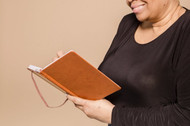The Church's Methods for Embracing Diversity and Inclusivity
Nov 16th 2023
Modern churches around the world have been making significant strides in promoting inclusivity in their congregations. One area where this transformation is evident is in the way clergy wear is chosen and utilized.
Many of these churches have recognized that by adapting the attire of priests and pastors to be more inclusive of gender, size, and age, they can send a powerful message of acceptance and belonging.
Let’s examine how specific methods of change in clergy wear have improved inclusivity.
Size Doesn’t Matter in Service
Changing rules regarding size and shape in clergy wear have significantly facilitated the inclusion of plus-size women in the clergy. Traditionally, standard vestment sizes posed a barrier to larger women pursuing a religious vocation.
However, as the church recognizes diversity and inclusivity, there's a growing trend towards offering a wider range of sizes and accommodating various body shapes. This shift not only ensures comfort but also sends a powerful message of acceptance.
Plus-size women and men can now confidently embrace their calling, knowing that they can find plus-size apostolic clothing that fits, enabling them to serve the church and congregation without hindrance.
Ensuring that attire is accessible and comfortable for all is a vital part of promoting inclusivity, and the following are now part of ensuring that plus-size apostolic clothing is part of clergy wear.
Tailored Fit
Offering tailored fit options for clergy robes and garments allows for a better fit regardless of body size. It makes sure that every clergy member feels comfortable and confident in their attire.
Adjustable Features
Some clergy attire now includes adjustable features like belts, ensuring that they can be comfortably worn by individuals of different body types.
Breaking Gender Barriers
Traditionally, the attire worn by clergy members was quite gender-specific. However, as society evolves and perceptions change, the church has been taking steps to embrace gender diversity within its ranks.
Gender-neutral Robes
One of the methods adopted by the church to promote inclusivity is the introduction of gender-neutral robes. These robes are designed to be more flexible in terms of fitting different body types and are free from traditional gender-based norms.
Color Choices
Churches have also broadened the color palette of liturgical vestments, allowing clergy to choose from a wider range of colors and styles that resonate with their personal identity, while still adhering to the church's customs.
Embracing Age Diversity
The church values the wisdom and guidance of clergy members of all ages. To ensure that age does not become a barrier to participation or leadership within the church, they have taken steps to adapt clergy wear.
Modern Designs
Contemporary designs for clergy attire appeal to younger generations, making them feel more connected and engaged with their faith. These designs maintain the solemnity of the garments while being appealing to a younger demographic.
Clergy wear has undergone a modern transformation to align with contemporary tastes and sensibilities. Traditional robes and vestments have evolved to incorporate sleeker designs, lighter fabrics, and more comfortable fits, such as plus-size apostolic clothing for both men and women.
Modern clergy wear often features minimalist styles that maintain a sense of reverence while embracing simplicity. These updates reflect a desire to connect with the younger generation and make religious attire more approachable.
Additionally, clergy members can now choose from a broader spectrum of colors, enabling them to express their faith in a way that resonates with today's diverse and dynamic world. This modernization bridges the gap between tradition and relevance in the church.
Timeless Classics
At the same time, the church continues to respect and utilize timeless designs that have been a part of its tradition for centuries. This ensures that older clergy members feel a strong connection to their faith and heritage.
Traditional clergy wear continues to exert a profound influence on modern robes and dresses worn by clergy members. The timeless designs, such as the cassock and chasuble, are rooted in centuries of religious tradition and carry deep symbolic significance.
These classic elements evoke a sense of reverence, connecting the present with the past, and reminding clergy of their spiritual heritage. While modern clergy attire may incorporate contemporary styles and materials, the enduring presence of traditional elements pays homage to the church's rich history and provides a link to the enduring spiritual values that continue to guide the clergy in their service to the faithful.
Inclusivity and Tradition Can Go Together
Inclusivity is a cornerstone of a welcoming and open-minded church community. Modern churches are rethinking and adapting clergy wear to accommodate all kinds of people who want to serve their church.
And the church is sending a powerful message of acceptance and unity. It recognizes that its congregation is a diverse tapestry of individuals, and by embracing this diversity through attire, it creates an environment where all can feel at home.
As the church continues to evolve, Divinity Clergy Wear will continue to reflect this march to inclusivity through attire, which will further strengthen the bond of the faithful, regardless of their gender, size, or age.
